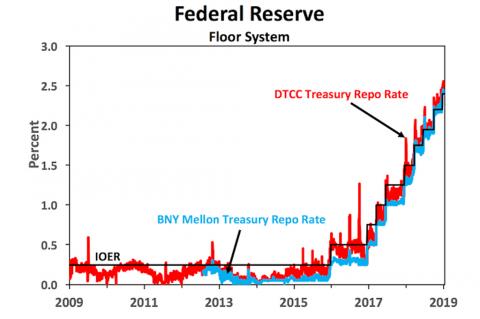To: Canadians Concerned about Monetary Policy
From: Jeremy Kronick and Steve Ambler
Date: October 11, 2019
Re: Lessons for Canada in the US Repo Rate Spike
Last month, overnight borrowing rates in the US skyrocketed as high as 9 percent as the overnight lending market froze and financial institutions with excess cash on deposit at the Federal Reserve failed to lend in the overnight repo (repurchase) market, where financial institutions, including banks, do short-term borrowing involving government securities.
This caused the Federal Reserve to inject liquidity into the overnight repo market for the first time since the financial crisis, and sparked anxious murmuring in the financial press.
Understanding this episode is important to anyone thinking about the operational aspects of monetary policy and whether the US example holds lessons for the Bank of Canada.
Both the Fed and the Bank of Canada conduct monetary policy in order to set a target overnight rate; in the case of the Fed, the Federal Funds Rate, and, in the case of the Bank of Canada, simply the overnight rate. These target rates are the overnight rates banks pay to lend to each other.
Both central banks use the tools at their disposal to adjust the supply of bank reserves (settlement balances in Canada’s case) in order to achieve their desired overnight rate. Under the “corridor system” in Canada, the Bank will adjust the supply of settlement balances such that the overnight rate sits in the middle of the Bank Rate, i.e. the rate the Bank of Canada charges banks for loans, and the Deposit Rate, the rate of interest on excess bank reserves left at the Bank of Canada.
On the other hand, under the US “floor system,” bank reserves will intersect with the demand curve at the interest-on-excess-reserves rate (IOER), the Fed equivalent of the Deposit Rate. There, in order to remove the opportunity cost of banks holding reserves, the rate must be at least equal to other short-term market rates of return. Given fluctuations in these other rates, the Fed typically sets the IOER higher in order to provide a buffer.
Under both systems, there are incentives for banks to lend at the target rate. Since both central banks lend to banks at an upper band (the Bank Rate for the Bank of Canada, as we saw, and discount rate for the Fed), this rate acts as a ceiling and encourages banks to look to each other to borrow, instead of to the central bank.
So what happened in the US last month?
For a variety of reasons, US bank reserves fell, causing a spike in overnight lending rates more than four times the Fed’s 1.75-2 percent target for the Fed Funds Rate. The expectation was that banks would move excess cash held at reserve into the repo market to take advantage of rates as they moved higher than the Fed Funds Rate.
This did not happen, and the Fed was forced to intervene with an injection of liquidity: that is to say it increased bank reserves. However, it was slow to do so, perhaps because under floor systems central banks don’t adjust the supply of reserves as frequently as in corridor systems. Also, the Fed, under the floor system, does not want to provide too many excess reserves, forcing it to straddle the point on the demand curve where changes in bank reserves have very little effect on the overnight rate, and where even small changes will cause the overnight rate to jump around. This can be very difficult, and has led to more volatile repo rates in the US compared to Canada (see Beckworth 2019 and his figures for Canada and the US below). This is despite the fact that one of the rationales for floor systems is that they lead to greater interest-rate stability.
Looking at this from a more macro perspective, the IOER, since it normally sits above other short-term rates, becomes the opportunity cost for banks who are thinking of lending to firms and households (see Beckworth 2018). This reduces their incentives to lend and hampers credit growth and the growth of deposits and broader measures of the money supply.
The floor system works well in a crisis period where liquidity dries up and bank reserves/settlement balances need to be increased. The Bank of Canada used the floor system in the crisis with daily settlement balances increasing to $3 billion (before 2009 they were $25 million). The Fed moved from the corridor to the floor system in 2008 and never left. The evidence suggests that the Bank of Canada got it right.
Source: Beckworth (2019) Note: DTCC is the Depository Trust & Clearing Corp., a processor of repurchase (repo) agreements between securities dealers. BNY is the Bank of New York Mellon. IOER stands for interest on excess reserves.
Jeremy Kronick is Associate Director, Research, at the C.D. Howe Institute and Steve Ambler is the David Dodge Scholar in Monetary Policy at the C.D. Howe Institute, and professor of economics at the school of management, University of Quebec at Montreal.
To send a comment or leave feedback, email us at blog@cdhowe.org.
The views expressed here are those of the authors. The C.D. Howe Institute does not take corporate positions on policy matters.







